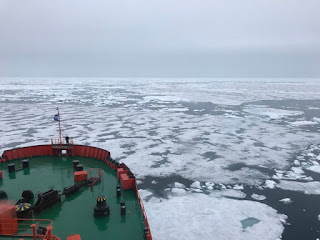Re: Fast Progress South

Hi Alex, Thank you for the updates and the photos, they really help with interpreting what we see in the satellite images! The Sentinel-1 satellite managed to get a picture of you heading south at 07:26 UTC yesterday (see attached). The freshly broken southbound track is clearly distinguishable from the faint northbound track. The melt is making seeing any features quite difficult, but we are picking smaller very dark patches that could either be ponds or openings, and some faint brighter traces of the ridging. The older ice you're seeing explains the difficulties the new Norwegian research icebreaker Kronprins Haakon had a week or so back north of Svalbard. They're in dry-dock for repairs following their encounter with the multi-year ice. Cheers, Nick ________________________________________________________________________________ Nick Hughes Norwegian Ice Service Leader of the Ice Service Forecasting Division for ...










